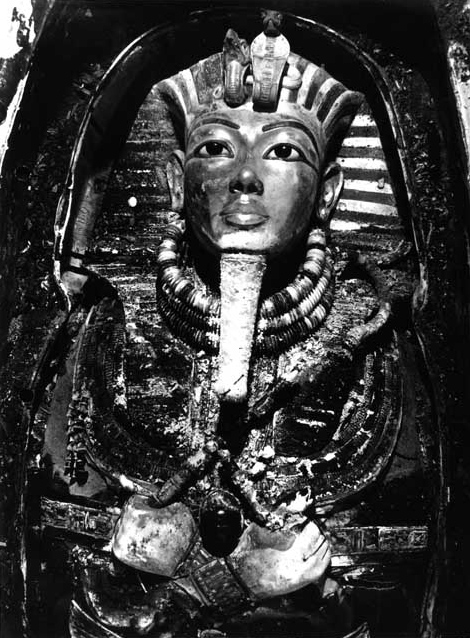
The elephant in the room of US politics right now appears to be just how old is too old to be president of the United States?
And the next question that comes along with that is “how common is it for a president, or some other head of state, a prime minister, or king or queen to die while still in power?”
Even though we have just had a national US election, suddenly, the country appears to be into another election season. Last week, the former US president, Donald Trump, announced he would run for president again in 2024. He is currently 76 years old. Meanwhile, just days ago, President Biden turned 80. This reminded voters that should he run for president and win in 2024, he would be 87 by the end of his term. Both political parties are engaged in a debate about age and the presidency. Are these men too old to be president of the United States? And how old is too old?
One of history’s most famous examples of the death of a leader is Tutankhamun, otherwise known as King Tut. He was just eight or nine years old when he took the throne in 1332 BC to rule over Egypt’s New Kingdom. Tut was short, just about five feet, six inches tall, and had a narrow waist, rounded hips, and an overbite. He was also deformed—incest ran in his family line. “Tutankhamun was physically disabled with a deformity of his left foot along with bone necrosis that required the use of a cane, several of which were found in his tomb,” reads his Wikipedia entry.
But perhaps the most interesting thing about this young ruler, and why we continue to talk so much about him today, is that he died so young, in 1323 BC, at the age of just 19. And he died while still on the throne and under somewhat mysterious circumstances. In attempts to explain this mysterious early death, it has been theorized that Tut had a variety of obscure and difficult-to-pronounce diseases and afflictions, including gynecomastia, Marfan syndrome, Wilson–Turner X-linked intellectual disability syndrome, Fröhlich syndrome, also known as adiposogenital dystrophy, Klinefelter syndrome, androgen insensitivity syndrome, aromatase excess syndrome in conjunction with sagittal craniosynostosis syndrome and Antley–Bixler syndrome, or one of its variants.
This all might sound like an impossible medical mystery, but modern medical analysis tools have helped to narrow the research and better pinpoint the cause of death, or at least reject certain theories. For example, in January 2005, King Tut’s mummy was CT scanned, showing that he had a partially cleft hard palate and possibly a mild case of scoliosis. It was also determined that he was repeatedly infected with the most severe strain of malaria, the deadly tropical disease brought about by infected mosquitoes. This, researchers theorized, may have caused a fatal immune response in Tut’s body or triggered circulatory shock. The determination was made, amazingly, when researchers discovered DNA from several strains of the malaria parasite in Tut’s more than 3,000-year-old mummified corpse.
Still, even this did not end the discussion over the cause of Tut’s death. The CT scan also showed that he had experienced a compound left leg fracture. One research team postulated “that his death was likely the result of the combination of his multiple weakening disorders, a leg fracture, perhaps as the result of a fall, and a severe malarial infection.” However, not all researchers agree. Murder by a blow to the head was theorized as a result of a 1968 X-ray that showed bone fragments inside Tut’s skull. But this theory was later disproved by further analysis of the X-rays and the CT scan. Another theory is that Tut may have been killed in a chariot accident due to a pattern of crushing injuries, including the fact that the front part of his chest wall and ribs were missing. But, here, too, archaeological evidence provides a response. The missing ribs were unlikely to be a result of an injury sustained at the time of death, say researchers, as photographs taken at the conclusion of King Tut’s initial excavation in 1926 show that the chest wall of the king was intact, still wearing a beaded collar with falcon-headed terminals. Rather, the front part of his chest was likely removed not by disease or accident but by robbers during the theft of the beaded collar.
And so, the big hype over exactly how King Tut died has continued to this very day. While it might seem absurd that so much scientific energy has been spent on the question, it is certainly an interesting scientific mystery. And it is not the only case in history where theories on the cause of a famous ruler’s death continue to receive significant attention. One only has to look to perhaps the most famous case of a leader’s death in office in history, John F. Kennedy, who was inaugurated at the age of 43, the youngest person to become president by election. The oldest, by the way, was Joe Biden, who took the presidential oath of office 61 days after turning 78.
But as the world knows all too well, JFK’s presidency was cut short when he was assassinated while traveling with his wife, Jacqueline, and the Governor of Texas, John Connally, in a motorcade traveling through the city of Dallas, Texas, on November 22, 1963, some 59 years ago to the day. “The car turned off Main Street at Dealey Plaza around 12:30 p.m.” and “as it was passing the Texas School Book Depository, gunfire suddenly reverberated in the plaza,” reads the very powerful account of events on the page of the JFK Presidential Library and Museum. “Bullets struck the president’s neck and head, and he slumped over toward Mrs. Kennedy. The governor was shot in his back. The car sped off to Parkland Memorial Hospital, just a few minutes away. But little could be done for the President. A Catholic priest was summoned to administer the last rites, and at 1:00 p.m. John F. Kennedy was pronounced dead.”
“The president’s body was brought to Love Field and placed on Air Force One,” continues the JFK Presidential Library and Museum post. “Before the plane took off, a grim-faced Lyndon B. Johnson stood in the tight, crowded compartment and took the oath of office, administered by US District Court Judge Sarah Hughes. The brief ceremony took place at 2:38 p.m.”
The funeral was held on Monday, November 25, 1963, at Arlington National Cemetery and attended by heads of state and representatives from more than 100 countries, with millions more watching on television. “Perhaps the most indelible images of the day were the salute to his father given by little John F. Kennedy Jr. (whose third birthday it was), daughter Caroline kneeling next to her mother at the president’s bier, and the extraordinary grace and dignity shown by Jacqueline Kennedy,” stated the JFK Library. “As people throughout the nation and the world struggled to make sense of a senseless act and to articulate their feelings about President Kennedy’s life and legacy, many recalled these words from his inaugural address:
All this will not be finished in the first one hundred days, nor in the first one thousand days, nor in the life of this administration. Nor even perhaps in our lifetime on this planet. But let us begin.”
These are surely important words for anyone grieving a loss. And, of course, JFK’s death did not pass with his actual death and funeral. What came next was an array of competing conspiracy theories on just how he died that continue to this day. The official US Congress inquiry into his death was called the Warren Commission, which determined that “Lee Harvey Oswald fired three shots at President John F. Kennedy. The second and third shots he fired struck the President. The third shot he fired killed the President.” However, the Commission did leave considerable room for speculation on other actors that may have played a role in the president’s death. For example, it stated that “scientific acoustical evidence establishes a high probability that two gunmen fired at President John F. Kennedy” and also that “on the basis of the evidence available…President John F. Kennedy was probably assassinated as a result of a conspiracy” but that “the committee is unable to identify the other gunman or the extent of the conspiracy.”
Some of the other conspiracy theories, according to the website spyscape.com, include that a mysterious man with a black umbrella present at the moment of assassination in Dallas killed JFK, the actor Woody Harrelson’s dad killed JFK, or, as laid out by Milton William Cooper, a former US radio personality and author: “JFK was assassinated by a ‘gas pressure device’ that aliens supplied to the driver of the presidential limo because JFK was about to expose Washington-alien collusion.”
While this sort of batting back and forth of theories may seem ridiculous in the face of cold hard facts and science, it is easy to see how facts get obscured, and science gets commandeered to prove a political point. Just look again at the question of age and health of the current president of the United States and the former president. One realizes that, like questions on the cause of death, questions on indications of health remain vitally important, even in our current times, with so many more medical analysis tools at our disposal. For example, there are all of the competing claims, and endless news stories, over the fitness level and state of health of President Biden, former President Trump, and former presidential candidate Hillary Clinton.
The people do not just want to know how a famous ruler will have died, but just how healthy they are in life too. Perhaps this is a means for understanding just how long they might live and when they might die. But either way, take a look at the nightly political news, and one realizes the issue is probably not going to go away anytime soon!









